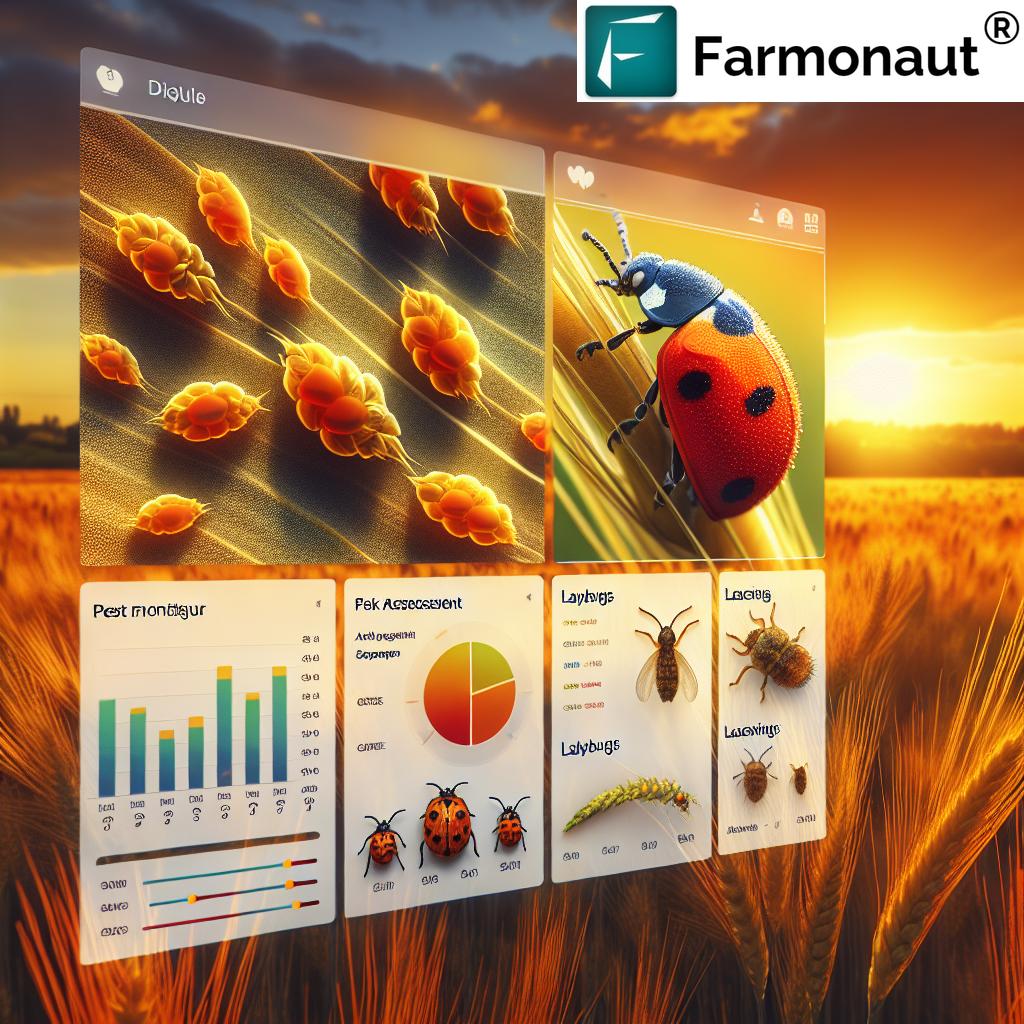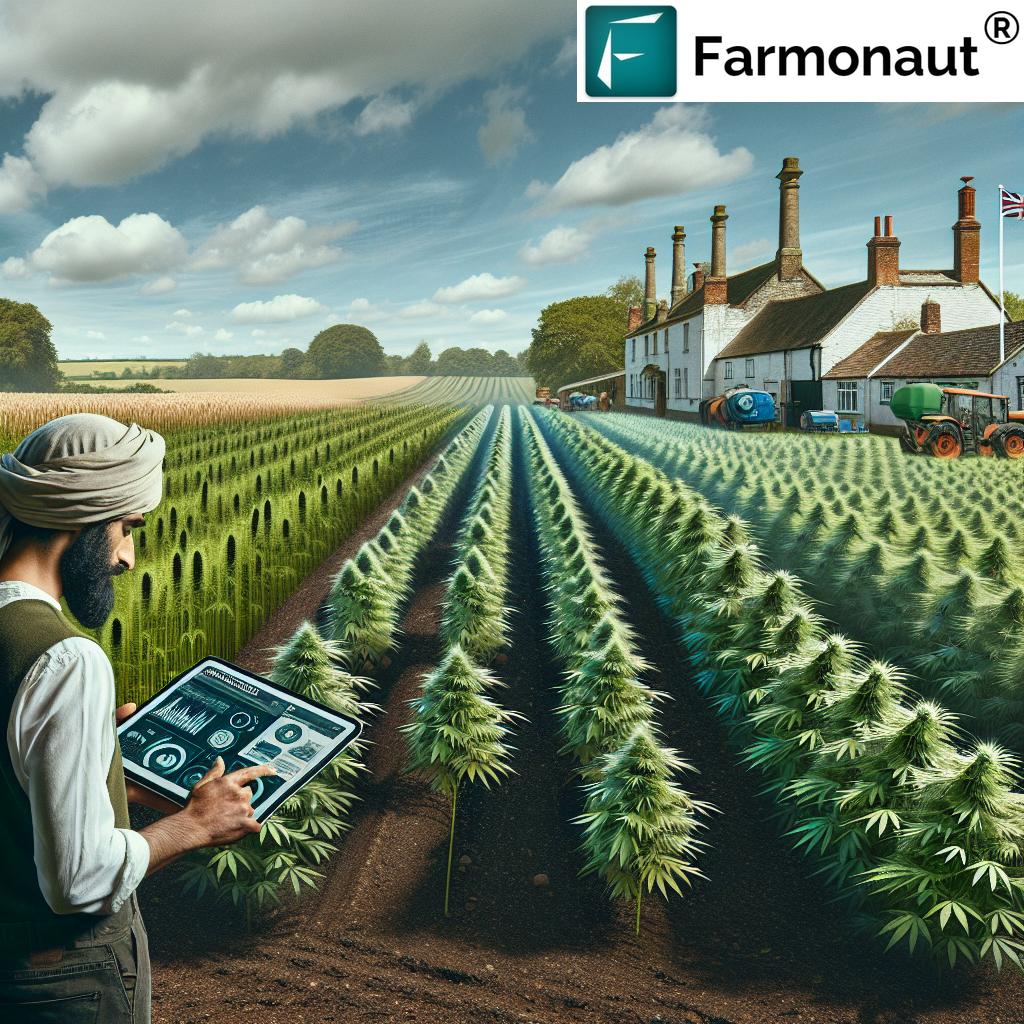7 Regenerative Agriculture Methods to Boost Soil & Biodiversity UK
Table of Contents
- Summary: Benefits of Regenerative Agriculture UK
- Key Regenerative Farming Principles in the UK
- Why Go Regenerative? UK Evidence and Outcomes
- 1. Cover Cropping for Soil Health
- 2. Integrated Arable Rotations & Increasing Farm Diversity
- 3. Reducing Soil Disturbance in Agriculture (Min Till/No Till)
- 4. Integrating Livestock into Arable Rotations
- 5. Organic Amendments & Compost Application
- 6. Agroforestry: Trees Within the UK Farm System
- 7. Prioritising Nature-Based Inputs Over Synthetics
- Modern Technology: How Farmonaut Supports Regenerative Agriculture
- Comparison Table of Regenerative Agriculture Methods in the UK
- Knowledge Exchange in Sustainable Farming
- FAQ: Regenerative Agriculture UK
- Conclusion: A Holistic UK Farm Future
“Cover cropping can increase soil organic matter by up to 21% in UK regenerative farms within five years.”
Summary: Benefits of Regenerative Agriculture UK
In the UK, regenerative agriculture is transforming farming by focusing on soil health improvement practices and encouraging a broader, more sustainable approach that delivers enhanced outcomes for both farmers and the environment. These methods support biodiversity in farming systems, restore natural nutrient cycles, and significantly reduce environmental harm.
A recent British Ecological Society report—created with insights from over 40 leading ecologists, academics, practitioners and farmers—shows clear evidence supporting positive impact on soil and biodiversity. However, it also highlights that adopting multiple regenerative farming principles in tandem is crucial for maximum effectiveness.
With Scotland dedicating over 70% of its land to agriculture, and ambitions set by the Scottish Government to lead in regenerative methods, the UK is at an inflection point. The integration of new technologies—like Farmonaut—is helping farmers access real-time data and precision management tools, making regenerative transitions practical, measurable, and scalable.
Let’s explore the key regenerative agriculture UK methods, how they benefit soil and biodiversity, and how continuous knowledge exchange between farmers, ecologists, and policymakers is paving the way for an environmental and economic win-win.
Key Regenerative Farming Principles in the UK
- Minimising soil disturbance via reduced or no-till practices
- Keeping soil covered (e.g., with cover crops, mulches, plant residues)
- Increasing farm diversity (multi-species rotations, intercropping, agroforestry)
- Integrating livestock into arable rotations
- Prioritising nature-based methods over synthetic inputs
According to Dr Roy Neilson, lead soil ecologist at the James Hutton Institute (JHI), “There are five principles of regenerative agriculture but there’s no one principle that delivers clear change on its own.” The effectiveness lies in regional adaptation and a holistic, farm-specific approach.
Implementing multiple techniques is essential for significant improvements in soil organic matter, nutrient cycling, and on-farm biodiversity.
Why Go Regenerative? UK Evidence and Outcomes
Growing evidence demonstrates:
- Enhanced soil health – Higher organic matter, improved soil structure, and increased microbe activity
- Greater biodiversity – Boosts in both above and below-ground life (pollinators, birds, earthworms, microfauna)
- Reduced environmental harm – Lower synthetic inputs, erosion, and run-off; better carbon sequestration
Bare fields are all too common in winter, but data shows that practices like cover cropping, integrating livestock into arable rotations, and diversifying cropping systems are particularly effective at restoring vital ecosystem functions. The Scottish Government regenerative agriculture programs continue to support research and implementation, highlighting Scotland‘s leadership in the field.
Let’s break down the seven most effective regenerative agriculture methods currently reshaping UK farming systems!
1. Cover Cropping for Soil Health
Cover cropping involves planting non-cash crops (e.g., clover, vetch, phacelia, winter rye) outside of the main growing season to keep soil covered year-round. In the UK, this practice is a cornerstone of soil health improvement practices and is strongly supported by evidence in the British Ecological Society’s report.
Benefits of Cover Cropping
- Builds soil organic matter: Natural root biomass and above-ground residues break down, returning carbon to the soil
- Improves soil structure: Deep rooting species open up compacted layers and increase water infiltration
- Enhances nutrient availability: Legumes fix atmospheric nitrogen, reducing the need for synthetic fertilisers
- Suppresses weeds, pests & diseases: A competitive living groundcover blocks weeds and disrupts pest life cycles
- Supports biodiversity in farming systems: Increases habitat for pollinators and soil organisms
The impact of cover cropping for soil health is especially notable in UK conditions, where bare winter fields can rapidly degrade soil structure and organic content. Integrating species diversity in cover crops provides even more ecosystem benefits.
Interested in real-time monitoring of cover crop effectiveness, soil organic carbon changes, or evaluating biodiversity? The Farmonaut Carbon Footprinting tool provides actionable, satellite-based insights on carbon sequestration and farm sustainability.
Try it now:
Access Farmonaut’s Crop Health Monitoring Platform
2. Integrated Arable Rotations & Increasing Farm Diversity
Crop and weed ecology researchers, like Dr Lucie Büchi of the University of Greenwich, highlight rotational diversity as a primary lever for biodiversity and soil improvement. Integrated arable rotations mean alternating cereals with legumes, oilseeds, and cover/green manure crops—ideally across three or more years.
This method involves:
- Disrupting pest and disease cycles naturally
- Reducing the load on any one crop family (e.g., cereals)
- Improving soil fertility through varied rooting depths and organic matter returns
- Welcoming infield biodiversity (from microbes to pollinators)
Integrated arable rotations in the UK can boost on-farm biodiversity by as much as 30% compared to conventional methods!
“Integrated arable rotations in the UK can boost on-farm biodiversity by as much as 30% compared to conventional methods.”
This is why, alongside cover cropping, rotational systems remain among the best regenerative agriculture UK methods for achieving long-term soil health and biodiversity resilience.
3. Reducing Soil Disturbance in Agriculture (Min Till/No Till)
Minimising soil disturbance is a fundamental regenerative principle. In the UK, reduced tillage or no-till farming is gaining traction—but, as the evidence shows, its effectiveness is context-dependent due to UK climate and soil conditions.
- Reduces breakdown of organic matter and preserves soil structure
- Protects against erosion and run-off, especially during heavy winter rainfall
- Helps build earthworm populations
- Lower machinery costs and GHG emissions
However, transitioning directly to no-till may not always suit every arable farm system—especially with heavier, wetter UK soils. Pairing reduced disturbance with cover crops and livestock integration can yield stronger, more consistent results.
Monitoring field health after tillage changes is easy with Farmonaut Large-Scale Farm Management, giving managers the ability to visualize soil moisture, compaction, and cover performance at scale.
4. Integrating Livestock into Arable Rotations
Re-integrating sheep, cattle, chickens, or other livestock into arable rotations is a powerful way to:
- Add organic manures to the land, increasing fertility
- Control weeds, pests, and diseases naturally
- Cycle nutrients more efficiently
- Increase insect, bird, and microbe biodiversity
- Reduce the time and inputs needed for soil rehabilitation
Recent UK studies reveal that integrating livestock into arable rotations suppresses disease and weed pressure while boosting soil health and biology. It is especially effective in northern and western UK regions (including Scotland) with abundant permanent pasture.
Effective integration requires adaptive planning: using rotational grazing, limiting animal density, and matching livestock cycles to crop phases. Tools like Farmonaut Fleet Management help farmers optimise animal movement, grazing schedules, and resource use across fields—ensuring both environmental and operational benefits.
5. Organic Amendments & Compost Application
Application of composts, digestate, green manures, and similar organic amendments replenishes the soil with biologically active material. In regenerative systems, the aim is to build a living, resilient soil—with boosted organic matter and microbial abundance.
Benefits:
- Raises soil organic matter and carbon
- Buffers soil pH and toxicities
- Promotes beneficial soil biology
- Reduces reliance on chemical fertilisers
Using digital resource management tools like the Farmonaut Fleet Management app ensures timely distribution and optimum use of on-farm composted resources, minimizing resource wastage and maximising impact.
6. Agroforestry: Trees Within the UK Farm System
Agroforestry—the intentional integration of trees, shrubs, and hedgerows into arable and pasture landscapes—is a practiced and expanding area of regenerative agriculture UK.
- Improves microclimate and wind protection for crops/livestock
- Enhances soil stability and infiltration with deep-rooted trees
- Creates wildlife corridors, supporting biodiversity (birds, mammals, beneficial insects)
- Stores above and below-ground carbon
Many UK farms are now adding or restoring hedgerows and shelterbelts on arable fields—with strong positive outcomes for biodiversity, pollination, and pest management.
Want verifiable records of carbon sequestration and ecosystem improvements? Farmonaut’s Carbon Footprinting tools monitor and document the impact of on-farm agroforestry and tree planting projects.
7. Prioritising Nature-Based Inputs Over Synthetics
Regenerative agriculture encourages the replacement of synthetic fertilisers and pesticides with nature-based alternatives:
- Use of compost extracts, biofertilisers, and biocontrols
- Insectary strips and wildflower margins to attract beneficial species
- Reduced pesticide/fertiliser run-off, allowing native flora and fauna to rebuild
This step is integral for both soil health improvement practices and restoring biodiversity in farming systems.
For managers needing transparent supply chain data and environmental risk reporting, Farmonaut Blockchain-Based Traceability records natural input use and verifies regenerative claims, building trust with buyers and regulators.
Comparison Table of Regenerative Agriculture Methods in the UK
| Method Name | Description | Estimated Impact on Soil Health | Estimated Impact on Biodiversity | Implementation Difficulty (1-5) |
|---|---|---|---|---|
| Cover Cropping | Non-cash crops grown between or alongside main crops, keeping soil covered | +10–21% soil organic matter, improved aggregation | +20% pollinator diversity, macrofauna increase | 2 |
| Integrated Arable Rotations | Alternating cereals, legumes, and broadleaf crops over 3–5-year cycles | +12% soil carbon, reduced compaction | +30% field biodiversity | 3 |
| Reduced/No-Till Farming | Minimal soil disturbance using direct drilling and strategic tillage | +6% organic content, better structure (UK-conditional) | +10% soil invertebrates | 3 |
| Integrating Livestock | Grazing sheep/cattle/chickens in arable rotations or on cover crops | +12% nutrient cycling, microbe diversity | +15–25% in-field biodiversity | 4 |
| Organic Amendments | Applying compost, green manure, or digestate to fields regularly | +11% organic carbon, improved biology | +10% soil fauna | 2 |
| Agroforestry | Introducing trees/hedgerows within arable or grazing systems | +8% carbon, better moisture | +30% pollinator and vertebrate diversity | 4 |
| Nature-Based Inputs | Prioritising compost, biofertilisers, biological controls | +5% soil structure, better nutrient retention | +15% biodiversity | 2 |
Knowledge Exchange in Sustainable Farming
One of the keys to regenerative agriculture UK success is robust knowledge exchange. According to studies by the British Ecological Society and Scottish Government regenerative agriculture researchers, farmers are more likely to succeed when learning peer-to-peer.
- Attend local field days, webinars, and discussion groups
- Consult with organisations like JHI, SRUC, or university research centres
- Use digital platforms to access crop/soil/pest data (Farmonaut delivers both satellite insights and AI advisory for UK/Scottish systems)
For institutional and SME users, Farmonaut API and API Developer Docs provide seamless integration of crop, weather, and field condition data—as well as environmental analytics for research and policy use.
The transition to a regenerative system is often knowledge-intensive but worth the investment. As James Robinson, University of Edinburgh, notes: “Knowledge exchange involving trusted sources—ideally other farmers sharing experiences—is key to a farm’s successful transition.”
Modern Technology: How Farmonaut Supports Regenerative Agriculture UK
Regenerative farming is not about “going backwards.” The movement is increasingly digital, analytical, and forward-looking. Farmonaut is at the cutting edge of this transition, with advanced technology that makes regenerative transitions measurable, actionable, and affordable for UK farmers of all sizes.
Farmonaut’s Key Precision Agriculture Services:
- Satellite-based crop health monitoring: Spot moisture stress, disease, and vegetation indices (NDVI, etc.) at field or block level
- Jeevn AI Advisory System: Personalised, real-time farm recommendations based on live satellite and weather data
- Blockchain-based traceability: Track natural input usage and product journey—from farm to consumer. Learn more about product traceability.
- Carbon footprinting: Monitor emissions and carbon sequestration to meet sustainability or subsidy requirements (See Farmonaut’s Carbon Footprinting solutions)
- Resource and fleet management: Allocate equipment/fertiliser/machinery for resource savings. Explore fleet management solutions.
- Crop loan & insurance verification: Secure, satellite-based reports reduce risk and improve finance access for regenerative projects. (How Farmonaut’s system works)
- Large scale & plantation monitoring: Manage expansive or multi-site regenerative projects with ease. Discover the scaling potential.
Farmonaut is available via Android, iOS, and Web App (see links above). Users enjoy flexible subscriptions by hectare and frequency—ideal for scaling as regenerative practices are expanded.
FAQ: Regenerative Agriculture UK
-
What is regenerative agriculture?
It’s an approach to farming that restores and improves soil health, increases biodiversity, reduces synthetic input use, and enhances ecosystem services. It’s based on five main principles adapted to each farm’s context.
-
How does regenerative agriculture improve soil health?
By minimising disturbance, keeping soil covered, rotating crops, adding organic matter, and supporting soil biology. Practices like cover cropping and integrating livestock enrich organic matter, nutrient cycling, and structure.
-
Does regenerative farming boost biodiversity?
Yes. Integrated systems support more pollinators, birds, microbes, and mammals above and below ground. Arable rotations, agroforestry, and reduced chemical use play key roles.
-
Are these methods practical for all UK farms?
Most principles can be integrated into any farm system, but effectiveness and methods may differ by region, soil type, and climate. Start with small steps and grow as you learn.
-
How can digital technology help in a regenerative transition?
Tools like Farmonaut deliver live monitoring, precision input management, and scalable record keeping—empowering data-driven decision-making and transparency for farm managers and advisors.
-
Where can I find more information or get started?
Consult resources from the British Ecological Society, JHI, SRUC, and digital solution providers like Farmonaut. Local workshops and peer networks foster experience sharing.
Conclusion: A Holistic UK Farm Future
The impact of regenerative agriculture UK is clear: healthier soils, greater resilience, and biodiversity thriving across fields, pastures, and woodlands. The movement forward is holistic—linking tradition with cutting-edge science, nature-based methods with digital agriculture technology.
Although the transition is complex and regionally nuanced, UK farmers can start with any of these seven methods—ideally combining several for amplified results.
With real-time support, peer networks, and enabling tools like Farmonaut, our future farms can balance food production, environmental responsibility, and economic sustainability.
Ready to take your next step?
Access Farmonaut’s Platform Here
.

















